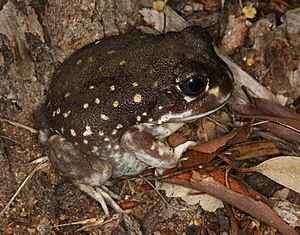Western spotted frog facts for kids
Quick facts for kids Western spotted frog |
|
|---|---|
 |
|
| Conservation status | |
| Scientific classification |
The western spotted frog (Heleioporus albopunctatus) is a special type of frog. It belongs to the frog family called Limnodynastidae. This frog lives only in Western Australia, which means it is endemic to that area.
You can find these frogs in many different places. They live in temperate forests and areas with temperate shrubs. They also like rivers that sometimes dry up, freshwater marshes, and rocky spots like granite outcrops. Sometimes, they even live near farms, pastures, or human-made places like ditches and canals.
Sadly, the western spotted frog is facing some challenges. Its natural habitat is shrinking, and something called salinity (too much salt in the soil) is also a problem for them.
Life Cycle and Reproduction
The western spotted frog has a unique way of laying its eggs. Unlike many frogs that lay eggs directly in water, these frogs lay their eggs on land.
Male frogs dig burrows, which are like underground tunnels. These burrows can be up to 1 meter (about 3 feet) deep! They dig them in sandy soil near water bodies that only appear sometimes, like after rain. The males start calling out to attract females in autumn (around March or April).
When a male and female frog mate, it happens inside the burrow. The female then lays a bunch of eggs. These eggs are covered in a foamy substance and are placed in a special chamber at the bottom of the burrow.
The eggs start to develop into tiny tadpoles while still inside the eggs. But for them to fully grow, they need winter rains. When it rains enough, the water bodies fill up, and the burrows get flooded. This allows the tadpoles to hatch from their eggs and finish growing in the pond.
Sometimes, tiny fly larvae can be found in the frog eggs. These larvae come from a fly called Aphiura breviceps. These flies might live in the frog burrows and eat the outer parts of the eggs. While some eggs might be affected, most of the frog eggs usually survive and hatch.
Frog Populations and Survival
Scientists have studied western spotted frog populations to understand how they are doing. They found that these frogs can move around well across their living areas. However, in some parts of Western Australia, like the central wheatbelt, there are signs that frogs in certain groups are closely related. This might mean that their habitat is broken up, making it harder for frogs to move between different areas and mix their genes.
One big study watched frog populations over time. They found that many frogs survived from one year to the next. This suggests that the western spotted frog is quite tough and can live even in areas changed by humans.
Another study looked at how likely frog populations were to survive. It found that groups of frogs that were connected to each other (like different neighborhoods in a city) were less likely to disappear than groups that were isolated. This means it's important for frogs to be able to move between different areas.
This study also showed that how well young frogs survive is very important for the whole population. If breeding ponds can be managed so they don't dry out too quickly, these frogs might continue to do well, even if the climate gets drier.
See also
 In Spanish: Heleioporus albopunctatus para niños
In Spanish: Heleioporus albopunctatus para niños


